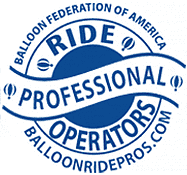
Hot Air Balloon Safety
We have an outstanding safety record.
You are important to us and we want you to know you’re in good hands while you have an exciting adventure.
Further ensuring your safety, Rocky Mountain Balloon Adventures is a member of the following organizations and associations. The goal of each is to set, ensure and exceed high safety standards, proper pilot certification and accountability, balloon equipment reliability, and ongoing education in the hot air ballooning field.
“Captain Mike and his crew are extremely experienced and focused on your safety. This was an amazing ride and view of Pagosa Springs.”
– Jerome H
“30+ year balloon ride company in Pagosa Springs, Colorado!! Outstanding safety record and one of the most exciting adventures you will encounter in your life!!!”
– Mike S, Socorro, NM
“Mike (the pilot/owner) canceled Friday due to weather. Mike offered a refund but I changed my plans to fly Saturday. I wouldn’t fly with anybody who doesn’t have integrity.”
– Greg F, Fond du Lac, Wisconsin
Come Float With Us?
How Do Hot Air Balloons Work?

A hot air balloon has three essential parts: the burner, which heats the air; the balloon envelope, which holds the air; and the basket, which carries the passengers.
Hot air balloons are based on a very basic scientific principle: warmer air rises in cooler air. Essentially, hot air is lighter than cool air, because it has less mass per unit of volume. A cubic foot of air weighs roughly 28 grams (about an ounce). If you heat that air by 100 degrees F, it weighs about 7 grams less. Therefore, each cubic foot of air contained in a hot air balloon can lift about 7 grams. That’s not much, and this is why hot air balloons are so huge — to lift 1,000 pounds, you need about 65,000 cubic feet of hot air.
To keep the balloon rising, you need a way to reheat the air. Hot air balloons do this with a burner positioned under an open balloon envelope. As the air in the balloon cools, the pilot can reheat it by firing the burner.
Piloting a balloon takes skill, but the controls are actually very simple. To lift the balloon, the pilot moves a control that opens up the propane valve. As you turn it, the flow of gas increases, so the flame grows in size. The pilot can increase the vertical speed by blasting a larger flame to heat the air more rapidly.
Hot air balloons also have a cord to open the parachute valve at the top of the envelope. When the pilot pulls the attached cord, some hot air can escape from the envelope, decreasing the inner air temperature. This causes the balloon to slow its ascent. If the pilot keeps the valve open long enough, the balloon will sink and this is how it eventually lands.
(Excerpts and diagram courtesy of Science, How Stuff Works, where you can read the full article.)



